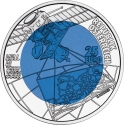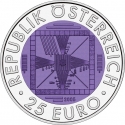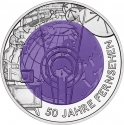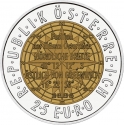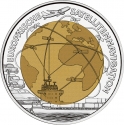You are about to finish your registration. Please check your mailbox (including spam folder). There should be a letter with a confirmation link. Check setting to make sure that your e-mail address is correct.
Send letter againDescription
Considered the world’s first true mountain railway, the Semmering Railway is still in full use more than 150 years after its construction. The 2004 edition of the Austrian Mint’s unique Silver Niobium series celebrates the anniversary of this technological wonder in fitting style.
The Semmering railway (German: Semmeringbahn) in Austria, which starts at Gloggnitz and leads over the Semmering to Mürzzuschlag was the first mountain railway in Europe built with a standard gauge track. It is commonly referred to as the world's first true mountain railway, given the very difficult terrain and the considerable altitude difference that was mastered during its construction. It is still fully functional as a part of the Southern Railway which is operated by the Austrian Federal Railways.
Even while being built, the Semmering railway was perceived as an effort of "landscape gardening", i.e. it attempted a harmonious combination of technology and nature. The unique travel experience which the Semmering railway offered contributed significantly to the original opening of the Semmering region for tourism. Numerous hotels and mansions are witnesses of this epoch. This enormous upswing to the turn of the century and the re-evaluation of the region as a winter sports area in the first third of the 20th Century were interrupted first by World War I and then by the changed recreational needs of the population. Therefore, this unique cultural landscape could be preserved with little change. A trip on the Semmering railway, which is in full use 160 years after its building, still impresses the traveller as a special experience by its varied landscape, the typical style of its mansions and the characteristic sequence of viaducts and tunnels.
In 1998 the Semmering railway was added to the list of the UNESCO World Heritage sites.
The coin contains 9 grammes of 900 Fine silver in its outer ring and 6.5 grammes of 998 pure niobium. Each coin is encapsulated, boxed and comes complete with a numbered certificate guaranteeing its authenticity.
Obverse

|
The railway’s durability is symbolised by its contrasting past and present locomotives on the coin’s obverse. Built between 1848 and 1854 by some 20,000 workers and featuring 14 tunnels, 16 viaducts and over 100 stone bridges, over the course of its 41 kilometre length this UNESCO World Heritage Site conquers an altitude difference of 460 metres. REPUBLIK ÖSTERREICH |
|---|---|
Reverse

|
The coin’s vivid green niobium core mirrors the colour of the landscape through which the railway passes, which is shown on the coin's reverse. Here a steam train is seen crossing a viaduct spanning a deep valley framed by the coin’s outer silver ring bearing the anniversary inscription. 150 JAHRE |
| Edge |
25 Euro
Silver Niobium Coin
Semmering Alpine Railway
Subscribe series
KM# 3109
Silver Niobium Coin
Semmering Alpine Railway
Characteristics
| Type | Commemorative Issue (Non-circulating) |
| Material | Bi-Metallic |
| Ring | Silver |
| Center | Niobium |
| Weight | 17.15 g |
| Diameter | 34 mm |
| Thickness | - |
| Shape |
|
| Alignment | Medal |
| Mint |
Austrian Mint
|


